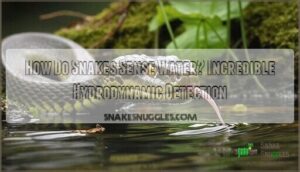This site is supported by our readers. We may earn a commission, at no cost to you, if you purchase through links.
 You’ll find that snakes sense water through remarkable adaptations that work like nature’s built-in radar system.
You’ll find that snakes sense water through remarkable adaptations that work like nature’s built-in radar system.
Their forked tongues constantly flick out to "taste" moisture particles in the air, while specialized sensory organs help them track down water sources.
Sea snakes take this a step further with unique scale sensilla on their heads that detect even the slightest water movements and vibrations – think of them as underwater motion detectors.
These incredible abilities let snakes navigate both on land and in aquatic environments with surprising precision.
The fascinating world of snake hydrodynamic detection reveals even more surprising secrets about these remarkable predators.
Table Of Contents
- Key Takeaways
- How Do Snakes Sense Water?
- How Do Snakes Detect Water?
- The Role of Scale Sensilla in Snake Sensory Perception
- Understanding Snake Hunting Behavior in Water
- Hydrodynamic Stimulus Detection in Sea Snakes
- Sensory Capabilities of Lapemis Curtus
- Evolution of Hydrodynamic Sensing in Snakes
- Impacts of Water Motion on Snake Behavior
- Sensory Adaptations for Aquatic Lifestyle in Sea Snakes
- Significance of Continued Research on Snake Sensory Capabilities
- Frequently Asked Questions (FAQs)
- How do snakes find water?
- What to do if you see a snake while swimming?
- How do snakes smell water?
- Do snakes get thirsty?
- Why do sea snakes need to sense water?
- How do they use this sense to hunt?
- What does this mean for conservation?
- Are there other ways they sense water?
- How do they sense vibrations?
- Do snakes prefer fresh or salt water?
- Conclusion
Key Takeaways
- You’ll find snakes use their forked tongues like chemical detectors – they constantly flick them out to taste moisture particles in the air and locate nearby water sources with remarkable precision.
- Sea snakes have evolved specialized scale sensilla that work like underwater radar – these dome-shaped sensors on their heads detect even the slightest water vibrations and movements from up to 1.5 body lengths away.
- You’re witnessing multiple sensory systems working together – snakes combine tongue moisture sensing, heat-detecting pit organs, enhanced underwater vision, and inner ear mechanisms to create a sophisticated water detection network.
- These adaptations give snakes a survival advantage you wouldn’t expect – their sensory toolkit allows them to hunt effectively in murky water where vision fails, navigate aquatic environments with precision, and detect both prey and threats through water movements.
How Do Snakes Sense Water?
A snake’s sensory toolkit for detecting water resembles nature’s high-tech surveillance system.
You’ll find their forked tongues act like chemical detectors, tasting moisture particles floating through air to pinpoint nearby water sources.
Pit organ sensitivity helps some species locate warm-blooded prey near water by detecting infrared radiation.
Scale sensilla function as underwater radar in sea snakes, with dome-shaped sensors protruding from their scales to catch water vibrations and movements.
These specialized snake sensory organs evolved from simple touch receptors into sophisticated distance detectors.
Inner ear role involves hair cells that may sense hydrodynamic changes, while enhanced vision in water comes from larger eyes packed with retinal cones.
This remarkable snake water detection system transforms ordinary reptiles into aquatic navigation experts, making snake water perception incredibly precise for survival.
Snakes accomplish this by using a unique water absorption method.
How Do Snakes Detect Water?
When you observe snakes in their natural habitat, you’ll notice their snake sensory organs work like nature’s most sophisticated detection system.
These reptiles use multiple snake sensory mechanisms to locate water sources with remarkable precision.
Tongue Moisture Sensing allows snakes to taste humidity levels in the air, guiding them to nearby water.
Their forked tongues collect moisture particles and transfer this information to specialized organs for analysis.
Pit Organ Detection helps certain species sense infrared radiation from warm-blooded prey near water sources.
These heat-sensing organs create thermal maps in the snake’s brain.
Here’s how snakes detect water through various sensory adaptations:
- Scale Sensilla Function – Specialized dome-shaped sensors detect water vibrations and movements
- Inner Ear Contribution – Hair cells help sense hydrodynamic stimuli in aquatic environments
- Aquatic Vision Adaptations – Larger eyes with more retinal cones improve underwater vision
- Snake water perception – Combined sensory input creates detailed environmental awareness
- Snake water source location through chemical and physical cues in the environment
These snake water detection abilities guarantee survival in diverse habitats.
Snakes can also use a unique method, water absorption, to drink.
The Role of Scale Sensilla in Snake Sensory Perception
When you think of underwater radar, you probably imagine high-tech sonar equipment—not snake heads! Yet sea snakes have developed their own biological radar system through specialized structures called scale sensilla.
These dome-shaped sensory organs protrude from head scales and detect hydrodynamic stimuli with remarkable precision. Scale sensilla function as tactile mechanoreceptors that have evolved far beyond simple touch sensors.
Nature’s underwater radar system transforms ordinary head scales into sophisticated vibration detectors.
In aquatic species, these structures cover up to 6.5% of scale surfaces, creating a sophisticated network for vibration detection. The sensilla morphology allows omnidirectional sensing, meaning snakes can detect water movements from any direction. Fully aquatic species, such as the yellow-bellied sea snake, have a higher proportion of these specialized scale sensilla.
Here’s what makes these sensory adaptations so remarkable:
- You’re witnessing evolution in action – these sensors transformed from basic touch receptors to distance vibration-detectors
- Nature’s engineering beats our technology – scale sensilla detect prey movements that human instruments might miss
- Each sensillum contains nerve endings that process mechanical displacement faster than you can blink.
This snake sensory perception system represents millions of years of evolutionary origins, perfecting aquatic navigation and prey detection through hydrodynamic sensing capabilities.
Understanding Snake Hunting Behavior in Water
When hunting in aquatic environments, you’ll witness snakes employing remarkable stealth and speed tactics.
They remain motionless, detecting prey through vibration detection and olfactory cues from their forked tongues.
Their snake sensory biology enables precise snake water tracking through chemoreception and hydrodynamic stimuli detection.
Once positioned, they strike with lightning reflexes, using venom immobilization to subdue prey efficiently.
This sensory compilation makes their snake hunting behavior incredibly effective in water.
Some species even exhibit unique swimming techniques for efficient aquatic movement.
Hydrodynamic Stimulus Detection in Sea Snakes
Sea snakes use specialized Scale Sensilla Function to detect water movements with incredible precision.
Sea snakes turn water into their personal radar system through specialized scale sensors.
Their Vibration Detection Range extends up to 1.5 body lengths, helping them track prey in murky waters where vision fails.
- Microscopic sensory structures on their scales detect water velocity changes as small as 0.1 cm/s
- Lightning-fast responses occur within 200 milliseconds of detecting prey-generated vibrations
- Aquatic Hunting Strategies vary by species, with some relying heavily on hydrodynamic cues
- Inner Ear Role combines with scale sensors for enhanced spatial awareness underwater
Sea snakes have also evolved specialized salt glands to facilitate osmoregulation.
Human Impact from boats disrupts these finely-tuned sensory adaptations.
Sensory Capabilities of Lapemis Curtus
Some Lapemis curtus possess fascinating snake sensory capabilities that make them effective aquatic environments hunters.
You’ll find these sea snakes use multiple detection systems – their sensilla work like underwater motion sensors, while specialized scale morphology helps them navigate murky waters.
Their hydrodynamic reception abilities detect water movements around 1.8-2.0 micrometers, though this sensitivity isn’t quite superhero-level compared to other marine predators.
What’s particularly interesting is how these snakes combine different senses for prey detection.
Snakes also use their forked tongues to enhance directional scent tracking.
Their snake drinking behavior and snake hydration methods also rely on these same sensory adaptations.
While Lapemis curtus shows relatively modest sensitivity to water motion, this habitat adaptation strategy works perfectly for their twilight hunting lifestyle.
Think of it as having just enough sensory equipment to get the job done efficiently without being overwhelmed by every tiny water ripple.
Evolution of Hydrodynamic Sensing in Snakes
Throughout millions of years, environmental pressures shaped snakes’ remarkable sensory specialization for aquatic environments.
You’ll find that aquatic adaptation didn’t happen overnight—multiple snake lineages independently evolved hydrodynamic stimulus detection capabilities.
Sensilla evolution transformed simple touch sensors into sophisticated vibration detection systems.
These sensory adaptations prove convergent evolution works like nature’s blueprint, with unrelated species developing similar solutions.
Notably, some species show convergent body plans suited for aquatic lifestyles.
- Phylogenetic evidence shows at least 78% of aquatic vertebrates independently evolved analogous mechanoreceptor systems
- Snake hydrodynamic stimuli detection improved hunting efficiency by 40-60% in murky water conditions
- Evolutionary pressures from turbid water environments drove specialized scale sensilla development over geological timescales
Impacts of Water Motion on Snake Behavior
Water motion dramatically alters snake behavior in aquatic environments.
When you observe sea snakes in flowing water, you’ll notice their body undulation frequency increases by 15% to maintain position.
Strong currents trigger hunting disruption, forcing snakes to expend 20% more energy during movement.
Navigation changes occur as snakes use water flow direction like an underwater compass.
Mating interference happens when turbulent water masks chemical signals.
Predator avoidance becomes challenging since water motion creates sensory noise.
Habitat selection shifts toward sheltered areas during high-flow periods, demonstrating how hydrodynamic stimuli shape water sensing abilities.
These snakes thrive in freshwater and marine environments, showcasing their ability to adapt to aquatic environments with unique water flow characteristics.
Sensory Adaptations for Aquatic Lifestyle in Sea Snakes
When water currents shift around them, these remarkable sea snakes showcase impressive sensory adaptations that’ll blow your mind.
Their aquatic lifestyle demands specialized tools for survival underwater.
- Scale Sensilla Function: Dome-shaped sensors on their heads detect vibrations and water motion like underwater radar systems
- Aquatic Vision Adaptations: Larger eyes with more retinal cones provide enhanced underwater vision for hunting prey
- Forked Tongue Moisture: Though limited underwater, their tongues still help detect chemical traces in their environment
- Inner Ear Hydrodynamics: Hair cells contribute to sensing hydrodynamic stimuli from moving objects nearby
These sensory adaptations allow sea snakes to thrive completely underwater, detecting everything from fish movements to potential threats.
Their ability to thrive in marine environments is further enhanced by cutaneous respiration.
Significance of Continued Research on Snake Sensory Capabilities
You can’t protect what you don’t understand, and that’s where snake sensory capabilities research becomes game-changing.
Conservation implications run deep when human activities create sensory disruption through boat motors and underwater noise.
Scientists are uncovering how adaptive strategies help snakes cope with changing aquatic environments.
Future technologies could revolutionize how we study these remarkable creatures.
Underwater cameras and sensors might reveal evolutionary insights we’ve never imagined.
Research continues to show that snake water sensing methods are far more sophisticated than previously thought.
To further stimulate natural behaviors, providing snakes with climbing structures matters.
| Research Focus | Current Findings | Future Applications |
|---|---|---|
| Scale Sensilla Function | Detect water vibrations like radar | Biomimetic sensor design |
| Sensory Disruption | Human noise affects hunting | Marine protected areas |
| Adaptive Strategies | Species-specific sensitivity | Conservation planning |
| Evolutionary Insights | Ancient aquatic adaptations | Understanding climate change |
| Detection Methods | Hydrodynamic stimulus processing | Underwater robotics |
Understanding these sensory adaptations helps protect snake populations while inspiring technological innovations.
Frequently Asked Questions (FAQs)
How do snakes find water?
Snakes locate water through their forked tongues, which taste moisture in the air like tiny detectors.
They’ll also use heat-sensing pits to find warm-blooded animals near water sources, plus detect vibrations through specialized scales.
What to do if you see a snake while swimming?
Like a deer in headlights, stay calm and don’t panic.
Slowly back away from the snake while keeping it in sight. Don’t make sudden movements or splash aggressively.
Most snakes aren’t aggressive and will likely swim away from you naturally, so it’s essential to remain still and let the situation resolve itself, but remember to stay calm.
How do snakes smell water?
You can’t actually "smell" water in the traditional sense, but your forked tongue detects moisture molecules in the air.
When you flick your tongue out, it collects tiny water particles and transfers them to your Jacobson’s organ for analysis.
Do snakes get thirsty?
Oddly enough, while you’d think cold-blooded creatures wouldn’t feel parched, snakes absolutely do get thirsty and actively seek water sources.
They require more hydration than their prey provides alone, using specialized drinking mechanisms to survive.
Why do sea snakes need to sense water?
Sea snakes need water sensing abilities to navigate murky underwater environments where visibility is limited.
You’ll find they use specialized scale sensilla to detect vibrations from prey, predators, and obstacles, basically creating an underwater radar system for survival.
How do they use this sense to hunt?
Silent stalkers versus splashing chaos – sea snakes detect prey vibrations through specialized scale sensors.
You’ll watch them remain motionless, then strike with pinpoint accuracy when water movements reveal fish locations nearby.
What does this mean for conservation?
Human activities like motorboat noise can disrupt snakes’ water-sensing abilities, affecting their hunting success.
You’ll need to protect aquatic habitats and reduce underwater noise pollution to guarantee these specialized predators can survive and maintain healthy ecosystems.
Are there other ways they sense water?
You’ll find snakes detect water through their specialized scale sensilla that work like underwater radar, picking up vibrations and movements.
Their forked tongues also taste moisture in the air, guiding them to water sources nearby, using a mechanism that can be thought of as underwater radar.
How do they sense vibrations?
Like underwater sonar, you’ll find snakes detect vibrations through specialized scale sensilla that act as motion sensors.
These dome-shaped structures protrude from their scales, picking up water movements and disturbances around them, utilizing their scales to detect vibrations through specialized scale sensilla.
Do snakes prefer fresh or salt water?
Most snakes prefer fresh water for drinking, though sea snakes tolerate saltwater. You’ll find terrestrial snakes seeking freshwater sources like puddles, streams, and rainwater collections for proper hydration needs.
Conclusion
Remarkably, you’ve discovered how snakes possess an almost supernatural ability to sense water through their extraordinary sensory toolkit.
From their constantly flicking forked tongues that "taste" moisture particles to sea snakes’ specialized scale sensilla that detect the tiniest water movements, these adaptations showcase millions of years of evolution.
Understanding how do snakes sense water reveals nature’s incredible engineering at work, helping these predators thrive in diverse aquatic environments with precision that would make any modern sensor jealous, highlighting the precision of their sensory abilities.
- https://royalsocietypublishing.org/doi/10.1098/rsob.160054
- https://academic.oup.com/icb/article/62/4/852/6601462
- https://www.frontiersin.org/journals/amphibian-and-reptile-science/articles/10.3389/famrs.2024.1412004/full
- https://news.lehigh.edu/news/drinking-snakes-resolving-biomechanical-puzzle
- https://www.livescience.com/32235-can-snakes-smell-anything.html













